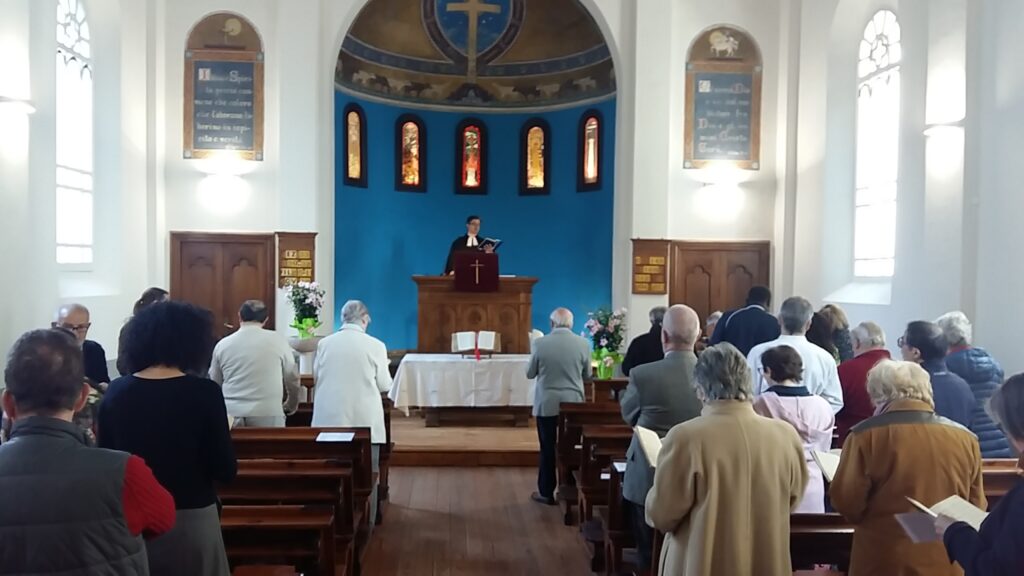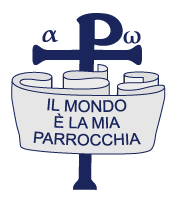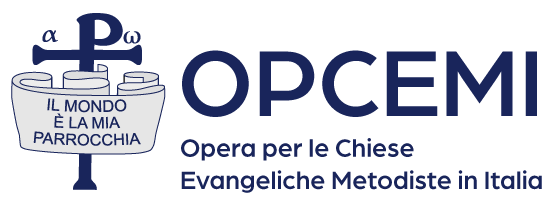METHODISM IN ITALY


Our symbol contains some extremely well-known and widespread Christian identifying marks-the alpha and omega and the Christogram, “chi” and “ro” of Christs, with the “chi” contained in the cross.
The Methodist peculiarity lies just in the slogan “The World Is My Parish,” which is a very famous dictum of John Wesley, founder of Methodism, which is intended to emphasize the essentially missionary character of the Church and the dimension of faith that is also expressed through a strong engagement to social justice and the rights of the most disadvantaged (Methodism not coincidentally has made a strong contribution to important civil battles, such as those for the abolition of slavery and those for the defense of workers’ rights and dignity).
Methodism appeared on Italian history in 1859 with the arrival of William Arthur, secretary of the Wesleyan Methodist Missionary Society in London. He toured Italy to learn more about the social and political sides of the Risorgimento. In his interesting report “Italy in transition,” he will affirm the need to open a missionary camp in our country, not to found a Methodist Church, but to support the evangelicals already present (Waldensians and Freethinkers) with the engagement for a religious reform in the evangelical sense that would provide a spiritual support to the ferments of political and cultural changes.
In 1860 the Wesleyan Society sent the young pastor Richard Green, who initially stayed in Florence, where he came in touch with exponents of the “free” churches (Gavazzi and Guicciardini); later going as Naples, recently liberated by Garibaldi. In 1861, having repatriated Green for health reasons, Pastor Henry J. Piggott was sent to Italy. The organization of the mission in the South, a territory whose specificities Piggott understood with great acuity, was assigned to Pastor Thomas W. Jones. In 1870 Pastor Leroy M. Vernon also coming in Italy, sent by the Episcopal Methodist Church of the United States of America (replaced after a few years by William Burt).
As the dream of building, with the other evangelicals, a single national Protestant church waned, Piggott and Vernon began to organize their respective denominational churches: Piggott the Wesleyan Methodist Church and Vernon the Episcopal Methodist Church, agreeing, however, to do complementary, non-competitive work.
Although originating from foreign missions, the Methodist Churches immediately became an active and dialogical component of Italian society, committed to bearing witness in the social, cultural, political and religious affairs of our country and striving for collaboration among all expressions of Protestantism.
Several local churches were established in major cities as well as in rural centers. The work of evangelization, particularly in some areas, also knew how to be popular and effectively proclaim freedom in Christ to the humblest sectors of the population: in the area of Mezzano in Emilia, for example, as in the industrial suburbs of Genoa; in the villages of the Maiella, as among the laborers of Ragusa (in Sicily) or among the workers employed in the construction of the Simplon tunnel. Were also established day and evening schools, professional training and job training institutes, and mutual aid organizations: remember Padua, Venice, La Spezia, Villa San Sebastiano, Intra with the Istituto G. Pestalozzi, Scicli, Naples and Portici with Casa Materna founded in 1905 by Pastor Riccardo Santi.
Very important was the printing of texts and magazines – such as L’Evangelista, founded in 1888 and closed by Fascism – and the formation of circles dialoguing with Italian culture in which leading figures such as Pietro and Alfredo Taglialatela took part.
The civil commitment in defense of the rights of workers and fishermen in Pozzuoli at the turn of the 19th and 20th centuries, carried out by the Wesleyan pastor Francesco Sciarelli – a former Friar who had joined the Garibaldians in 1860 and later adhered to Methodism – to whom we owe the Campaign for Sunday break, should be emphasized; while in Scicli (RG) in the early decades of the twentieth century operated Episcopal pastor Lucio Schirò, who, as a member of the Socialist Party, took office as mayor in opposition to the rising Fascism.
During the two decades of the Fascist period, despite severe restrictions on freedom, churches pledged not to retreat into themselves. During those difficult years, the Methodist theological school in Rome welcomed Ugo della Seta and Ernesto Buonaiuti as its teachers.
With the financial crisis in the United States of America (1929), the Episcopal Methodist mission in Italy underwent a drastic downsizing. Italy’s entry into World War II against England and the United States made the two Methodist missions’ lives even more difficult.
Immediately after the war (1946) the two branches of Methodism united into the Evangelical Methodist Church of Italy, under the jurisdiction of the British Methodist Conference, until their autonomy (1962).
In a climate of renewed enthusiasm, in 1954 was founded in Velletri (Rome) Ecumene, a center for study, worship and community life that became a place for reconciliation, peace and justice among people. Ecumene was born thanks to the impulse of the I congress of the Italian Evangelical Youth, and very quickly it became characterized by a specific interest – which still continues today – in research on “Faith and Politics,” developing interesting lines of analysis, for example, on popular religiosity, Catholic culture, southernism, labor and vocation, and democracy.

Our symbol contains some extremely well-known and widespread Christian identifying marks-the alpha and omega and the Christogram, “chi” and “ro” of Christs, with the “chi” contained in the cross.
The Methodist peculiarity lies just in the slogan “The World Is My Parish,” which is a very famous dictum of John Wesley, founder of Methodism, which is intended to emphasize the essentially missionary character of the Church and the dimension of faith that is also expressed through a strong engagement to social justice and the rights of the most disadvantaged (Methodism not coincidentally has made a strong contribution to important civil battles, such as those for the abolition of slavery and those for the defense of workers’ rights and dignity).
Methodism appeared on Italian history in 1859 with the arrival of William Arthur, secretary of the Wesleyan Methodist Missionary Society in London. He toured Italy to learn more about the social and political sides of the Risorgimento. In his interesting report “Italy in transition,” he will affirm the need to open a missionary camp in our country, not to found a Methodist Church, but to support the evangelicals already present (Waldensians and Freethinkers) with the engagement for a religious reform in the evangelical sense that would provide a spiritual support to the ferments of political and cultural changes.
In 1860 the Wesleyan Society sent the young pastor Richard Green, who initially stayed in Florence, where he came in touch with exponents of the “free” churches (Gavazzi and Guicciardini); later going as Naples, recently liberated by Garibaldi. In 1861, having repatriated Green for health reasons, Pastor Henry J. Piggott was sent to Italy. The organization of the mission in the South, a territory whose specificities Piggott understood with great acuity, was assigned to Pastor Thomas W. Jones. In 1870 Pastor Leroy M. Vernon also coming in Italy, sent by the Episcopal Methodist Church of the United States of America (replaced after a few years by William Burt).
As the dream of building, with the other evangelicals, a single national Protestant church waned, Piggott and Vernon began to organize their respective denominational churches: Piggott the Wesleyan Methodist Church and Vernon the Episcopal Methodist Church, agreeing, however, to do complementary, non-competitive work.
Although originating from foreign missions, the Methodist Churches immediately became an active and dialogical component of Italian society, committed to bearing witness in the social, cultural, political and religious affairs of our country and striving for collaboration among all expressions of Protestantism.
Several local churches were established in major cities as well as in rural centers. The work of evangelization, particularly in some areas, also knew how to be popular and effectively proclaim freedom in Christ to the humblest sectors of the population: in the area of Mezzano in Emilia, for example, as in the industrial suburbs of Genoa; in the villages of the Maiella, as among the laborers of Ragusa (in Sicily) or among the workers employed in the construction of the Simplon tunnel. Were also established day and evening schools, professional training and job training institutes, and mutual aid organizations: remember Padua, Venice, La Spezia, Villa San Sebastiano, Intra with the Istituto G. Pestalozzi, Scicli, Naples and Portici with Casa Materna founded in 1905 by Pastor Riccardo Santi.
Very important was the printing of texts and magazines – such as L’Evangelista, founded in 1888 and closed by Fascism – and the formation of circles dialoguing with Italian culture in which leading figures such as Pietro and Alfredo Taglialatela took part.
The civil commitment in defense of the rights of workers and fishermen in Pozzuoli at the turn of the 19th and 20th centuries, carried out by the Wesleyan pastor Francesco Sciarelli – a former Friar who had joined the Garibaldians in 1860 and later adhered to Methodism – to whom we owe the Campaign for Sunday break, should be emphasized; while in Scicli (RG) in the early decades of the twentieth century operated Episcopal pastor Lucio Schirò, who, as a member of the Socialist Party, took office as mayor in opposition to the rising Fascism.
During the two decades of the Fascist period, despite severe restrictions on freedom, churches pledged not to retreat into themselves. During those difficult years, the Methodist theological school in Rome welcomed Ugo della Seta and Ernesto Buonaiuti as its teachers.
With the financial crisis in the United States of America (1929), the Episcopal Methodist mission in Italy underwent a drastic downsizing. Italy’s entry into World War II against England and the United States made the two Methodist missions’ lives even more difficult.
Immediately after the war (1946) the two branches of Methodism united into the Evangelical Methodist Church of Italy, under the jurisdiction of the British Methodist Conference, until their autonomy (1962).
In a climate of renewed enthusiasm, in 1954 was founded in Velletri (Rome) Ecumene, a center for study, worship and community life that became a place for reconciliation, peace and justice among people. Ecumene was born thanks to the impulse of the I congress of the Italian Evangelical Youth, and very quickly it became characterized by a specific interest – which still continues today – in research on “Faith and Politics,” developing interesting lines of analysis, for example, on popular religiosity, Catholic culture, southernism, labor and vocation, and democracy.
